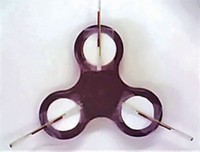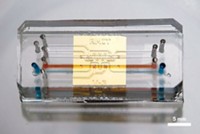Advertisement
Grab your lab coat. Let's get started
Welcome!
Welcome!
Create an account below to get 6 C&EN articles per month, receive newsletters and more - all free.
It seems this is your first time logging in online. Please enter the following information to continue.
As an ACS member you automatically get access to this site. All we need is few more details to create your reading experience.
Not you? Sign in with a different account.
Not you? Sign in with a different account.
ERROR 1
ERROR 1
ERROR 2
ERROR 2
ERROR 2
ERROR 2
ERROR 2
Password and Confirm password must match.
If you have an ACS member number, please enter it here so we can link this account to your membership. (optional)
ERROR 2
ACS values your privacy. By submitting your information, you are gaining access to C&EN and subscribing to our weekly newsletter. We use the information you provide to make your reading experience better, and we will never sell your data to third party members.
Analytical Chemistry
Microfluidic Device Separates Unlabeled Cells
Medical Diagnostics: A magnetic salt solution separates cell types in microfluidic device
by Corinna Wu
March 12, 2012

Magnets separate types of human cells in a newly developed microfluidic device. But unlike previously designed magnetic sorting systems, this one doesn’t require labeling the cells first (Anal. Chem., DOI: 10.1021/ac201505j). The new method could lead to cheaper, faster medical diagnostic devices, the researchers say.
Scientists use cell-sorting methods to isolate cells for experiments or to diagnose disease. For example, they might separate rare cancer cells from blood to diagnose breast or colon cancer. In a well-established technique called magnet-activated cell sorting, or MACS, researchers use magnetic particles attached to antibodies for a cell-surface protein to tag desired cell types. They then pass the collection of cells through a magnetic field to separate tagged from untagged cells. Some researchers want to skip the labeling step.
“Processing steps cost money and time, and you never get 100% efficiency in labeling and recovery,” says Jeffrey Chalmers, a professor of chemical and biomolecular engineering at Ohio State University, who was not involved in the new study. Researchers also have to chemically remove the magnetic labels from sorted cells before they can use the cells in experiments or in medical treatments, says Je-Kyun Park, of the Korea Advanced Institute of Science and Technology. That process, he says, can lead to fewer viable cells.
To avoid labeling, Park and his colleagues built a lab-on-a-chip device that separates types of cells by using a magnetic salt solution. The salt, gadolinium-diethylenetriamine pentaacetic acid, is biocompatible and doesn’t damage the cells, Park says. Doctors already use it as a contrast agent in magnetic resonance imaging procedures.
The cells travel through the device’s microfluidic channel. A magnet sits above this channel, and the resulting magnetic field’s combined effect on the cells and solution is to push the cells away. The strength of the force pushing on the cells depends in part on the size of the cell, with larger cells experiencing a greater force. As a result, the stream of cells separates into multiple streams, according to cell type.
Park’s team tested the device using a mixture of lymphoma cells and red blood cells. The researchers used a microscope to monitor the streams of cells and found that the stream of lymphoma cells was more than 90% pure. This level of separation proves that the label-free method can effectively sort cells, Park says.
Ohio State’s Chalmers says that his group and others have tested parts of this method, such as manipulating the flow of cells in magnetic solutions, but Park’s group is the first to build a successful cell sorter using those principles.





Join the conversation
Contact the reporter
Submit a Letter to the Editor for publication
Engage with us on Twitter